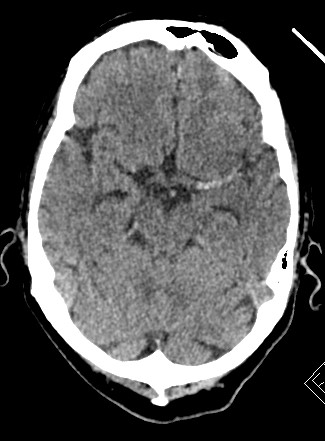Themes: Hyperacute Care, Thrombolysis, Complications.
| John is a 52 year old right handed male. He was found collapsed in the town centre. He was FAST positive (abnormal speech and couldn't lift his right arm) and has been brought in by a paramedic crew. You attend the stroke call as part of the stroke team. It is now 12.10 pm and he was last known to be well at 11.00 am when he drove to town and parked. A parking ticket in his wallet says 11.00. He is awake but there is no speech. He also does not appear to be moving his right arm and leg. He has a right facial weakness. His BP is 150/80 mmHg and Pulse 80/min and O2 sats 95%. He does not appear to see visual stimuli on his right side. You quickly examine him and calculate his NIHSS score to be 15. The consultant advises get a CT and bloods and is on her way. The team attempts to call his wife from details proved by paramedics. |  |
|---|
Questions
1. What is the FAST test
This is the Face Arm Speech Test and is a screening tests for stroke which can be done by the public or a paramedic. It is a very useful screening test for those suspected of having an acute stroke in those out of hospital and can be done with very little training. It has been advertised widely to try to improve the pubic knowledge of the signs of stroke so that emergency services are alerted and patients get to hospital early and so can have the benefit of reperfusion strategies such as thrombolysis and thrombectomy. It is not 100% reliable and some patients with very mild or posterior circulation strokes can be fast negative.

2. What is NIHSS score
This is a very quick reproducible neurological assessment on those likely to have stroke and is done in hospital. It focuses on very quickly picking up typical stroke deficits. The higher the score the larger the stroke and the worse the prognosis. It tends to underscore in posterior circulation strokes. Swallowing is not included. There is no need for any further neurological assessment when quickly preparing for reperfusion therapies. It is very important that this is done quickly before escalating. It is one of the first things that on a telemedicine consult that the consultant stroke physician will ask for and will often go through the marking with the referring person. See more information at NIHSS. There is free online training for it.

3. Why is contacting his wife so crucial
- His wife may know about past medical history e.g. a recent episode of GI bleeding or that patient is on Warfarin or that the patient has another condition that would be a contraindication to Thrombolysis.
- Wife or any witness may also be able to help with time of onset if there is uncertainty from other sources.
- Wife cannot give consent for anyone else but can support a best interest decision to thrombolyse a patient who lacks capacity. She may even have a Power of attorney for health and welfare and so be able to make decisions for the patient. Otherwise she can try to reflect what would be the patient's views.
- It is both kind and considerate to inform family as early as possible to come and emotionally support and be with the patient.
See Imaging

- The CT shows a long clot/thrombus in the Left MCA M1
- The consultant checks inclusion and exclusion criteria
- The consultant checks that the BP is < 185/110 mmHg. It is 160/90 mmHg
- The consultant rechecks that the CT is compatible with ischaemic stroke
- The consultant speaks to his wife by phone and explains that he needs thrombolysis and risk and benefits
- He is treated in best interests as he lacks capacity due to loss of capacity due to aphasia
4. What are the usual signs of a blocked Left and Right MCA (dominant)
Assuming right handed and dominant left cortex
Blocked Left MCA
- Right sided weakness (hemiparesis) - right face/arm/leg
- Right sided hemisensory loss
- Right homonymous hemianopia
- Dysphasia
Blocked Right MCA
- Left sided weakness (hemiparesis) - left face/arm/leg
- Left sided hemisensory loss
- Left homonymous hemianopia
- Neglect/Inattention
5. His weight is 70 kg and Alteplase is given as 0.9 mg/kg. How much is given and how is it given
- His weight is 70 kg so Alteplase dose is therefore 0.9 mg/kg x 70 = 63 mg
- This is prepared by the stroke nurse specialist
- This is prescribed and 10% (6 mg) is given as a bolus and the remaining 90% is given through an infusion pump
- This will usually require the opening of 2 x 50 mg vials which are made up
- The remaining 90% ( 57 mg) is given as an infusion over 1 hour
- The patient must be closely monitored for complications with 15 minute obs
6. What is Alteplase
A drug that activates tissue plasminogen which breaks down fibrin strands and therefore dissolves clots and allows blood to flow again. The main risks are anaphylaxis, angioneurotic oedema and bleeding which may be intracranial or extracranial. This is why very close monitoring is needed once Alteplase is started and patients need nursed in an environment that allows frequent observations with access to key support if any of the complications happen.
7. During the infusion he suddenly becomes less responsive and has a seizure . What would you do now.
- Immediately stop the Alteplase and check ABC and a set of observations.
- Start Oxygen. Check BM if hypoglycaemia possible.
- Escalate to the Medical Registrar or the stroke team.
- Once stabilised get a second CT scan to look for haemorrhage.
- Consider a phenytoin infusion if seizure persists or recures
- Continue frequent monitoring on the HASU
- If GCS < 9 then get anaesthetic review and discuss need for ventilatory support in an ITU bed
Signs of a new intracranial haemorrhage include increasing headache, nausea, vomiting, reduced GCS, a seizure or pupil changes. These warrant urgent repeat CT head and the Alteplase must be stopped immediately until the scan is done and reported.
The CT scan show no haemorrhage. His GCS is now 10. He is on the HASU. IV fluids are started. Because he is still within the window for thrombolysis it is now restarted. He is closely monitored. A CT is booked for the following day.
8. Why is a CT scan needed the next day
Alteplase can cause intracerebral bleeding and this may be seen in up to 5-6% of patients after having received it. This can be seen on the CT.
9. When can Aspirin be given
Aspirin is usually withheld until after a repeat CT head scan which is done approximately 24 hours after thrombolysis does not show any evidence of intracerebral haemorrhage. Once that is done the current stroke policy is to give Aspirin 300 mg either orally, by NG tube or rectally (PR) to patients with suspected ischaemic strokes. Aspirin 300 mg is usually given for 14 days and then switched to Clopidogrel 75 mg OD long term. If there is a history of dyspepsia or at high risk of peptic ulcer disease then Lansoprazole or another similar agent may be given. Some units give it as standard but it should be stopped once the patient is commenced on Clopidogrel. Occasionally the transition from Aspirin 300 mg to Clopidogrel 75 mg is started before 14 days.
10. What else do I need to check
All patients need an early swallowing assessment. This can be done simply by the bedside. This is very important as giving food or drink to someone with a poor swallow can result in aspiration and pneumonia. This is usually don by stroke specialist nurse.
11. The thrombolysis has finished and the patient is agitated and the BP is 210/110 mmHg. What would you do next
The patient is agitated and we know is dysphasic so cannot tell us what is wrong. Look for pain and distress. It didn't take long to realise that he had not passed urine for several hours and had had 1L of IV fluids. He was made comfortable and given a urine bottle and assisted. Unfortunately he still could not pass urine. Usually catheterisation is avoided in stroke patients especially after thrombolysis but acute urinary retention is an absolute indication. It is key to be extra gentle to avoid any urethral bleeding. A bladder scan suggested a residual of 500 mls. Once catheterised his BP settled to 150/80 mmHg and the patient was comfortable.
12. If there had been no identifiable cause for the BP rise what would you have treated him with ?
IV labetalol is the usual drug of choice in those who can take a beta blocker. It can be given as 10 mg doses which may be repeated. The key is to go slowly and avoid large drops in BP but target is to get BP comfortably under 180/110 mmHg in the 12-24 hrs after alteplase to minmise the risks of haemorrhagic transformation and bleeding into the stroke. For those who cannot take a beta blocker consider a GTN infusion though this can cause a severe headache. If the patient can swallow I might start a small dose of oral amlodipine 5 mg in addition to parenteral agents but the best advice is to follow local guidelines.
| Note: The plan is to keep the website free through donations and advertisers that do not present any conflicts of interest. I am keen to advertise courses and conferences. If you have found the site useful or have any constructive comments please write to me at drokane (at) gmail.com. I keep a list of patrons to whom I am indebted who have contributed. If you would like to advertise a course or conference then please contact me directly for costs and to discuss a sponsored link from this site. |